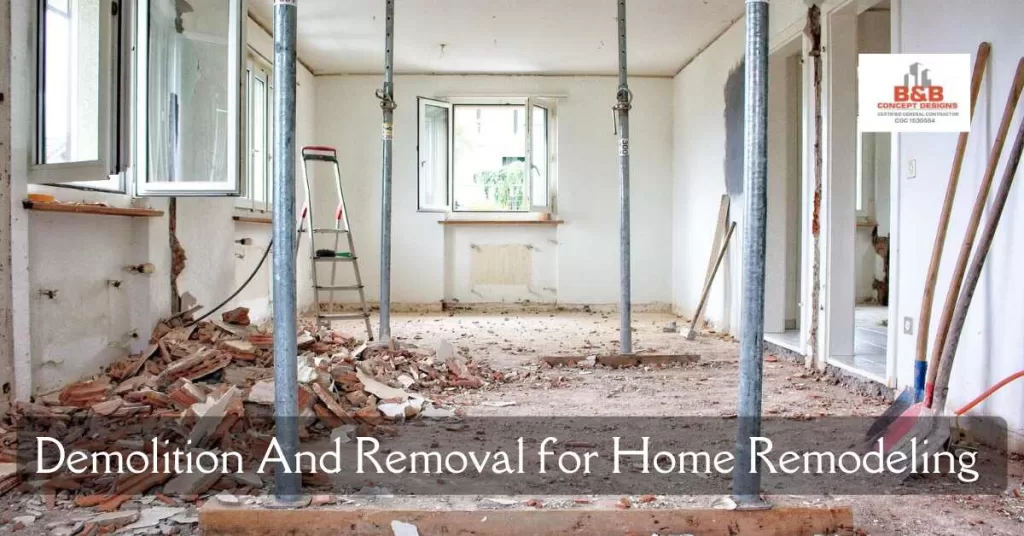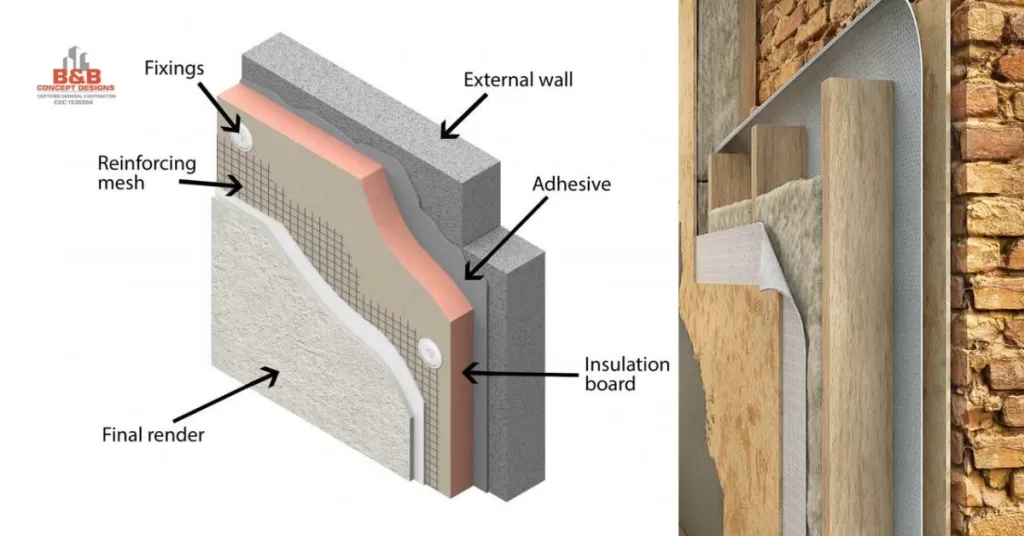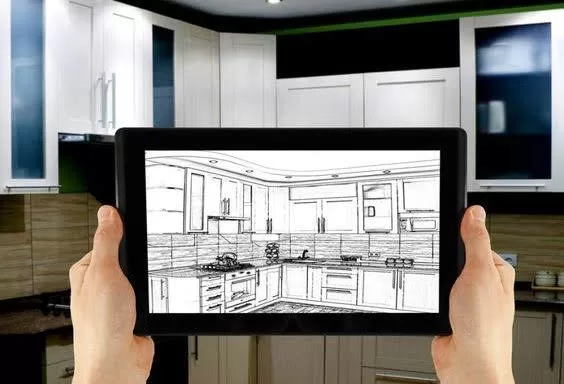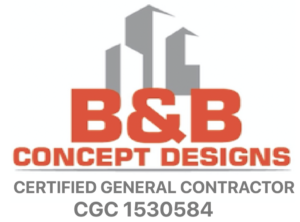There is one thing that comes to mind for all of us before embarking on a remodeling project. When remodeling a house what comes first? When remodeling a house, planning and design come first. Ensure you obtain the necessary building permits before construction starts.
Remodeling a house is an exciting and complex endeavor that requires a well-thought-out strategy for success. Starting with a comprehensive plan, homeowners must prioritize their design objectives, align them with their budget, and schedule the work systematically. Securing permits is vital to ensure that the renovation complies with local building codes and regulations.
Professional consultations with architects, designers, and contractors are also crucial steps in laying the groundwork for a smooth remodelling process. Once these initial steps are in place, the actual physical work can begin, typically starting with demolition or gutting of the existing space, followed by structural updates and installations.
Emphasizing careful planning and adherence to professional advice like B & B Concept Design will lead to a successful remodeling project that enhances both the house’s functionality and aesthetic appeal.
How To Plan And Organize A Successful Home Renovation
Planning and organizing a successful home renovation requires a solid strategy. It’s like mapping a journey. You need to know your destination, the best route, and what you’ll pack. Renovating a house is similar. It’s crucial to plan the steps before diving in. A good plan can save time, reduce stress, and ensure your remodel meets your vision.
Whole Home Remodeling Steps By Step Guide
- Conceptualize Your Vision: Pin down what you want from the remodel. Use pictures or idea boards.
- Create a Budget: Know your finances. Decide what you can spend on the renovation.
- Hire Professionals: Find skilled contractors. Architects and designers may also be necessary.
- Select Materials: Choose flooring, fixtures, and paint early. It keeps your project on schedule.
- Plan the Sequence: Begin with structural changes. Follow with painting, flooring, and fixtures.
- Secure Permits: Get necessary approvals from local authorities to avoid delays.
- Prepare for Challenges: Set aside a contingency budget for unexpected issues.
Don’t Forget About Utilities Systems
Utility systems are the lifeblood of your home. Water, gas, and electricity need careful consideration. Upgrade wiring and plumbing if needed. Plan for HVAC needs. Ensure utilities support your renovated space’s function and comfort.
Our Whole Home Remodel Checklist
- Finalize Design: Confirm the final plan before construction starts.
- Storage Solutions: Keep your belongings safe during work. Rent storage if necessary.
- Communicate with Your Team: Regular meetings with contractors keep everyone aligned.
- Quality Control: Monitor the work. Make sure it matches your standards.
- Landscaping Considerations: Protect your yard. Plan for changes that complement your house.
- Interior Decoration: Decide on furniture, decor, and final touches while construction is ongoing.
- Final Walkthrough: Check every detail. Ensure the project’s completion to your satisfaction.
Get Necessary Permits
Embarking on a remodeling journey? Securing the right permits should top your to-do list. Without these legal documents, your renovation could face costly delays or even a full stop. Let’s grasp how to initiate the permit process correctly.
Research Local Building Codes
Building codes vary by location. They ensure safety and compliance with regional standards. Kickstart your remodeling with diligent research into your area’s specific codes. This vital step prevents future hiccups and maintains the integrity of your home’s structure.
- Visit your local government website.
- Consult professionals for complex regulations.
- Understand zoning laws affecting your property.
Apply For Permits
A successful application process is next. Gather your project details and submit them to the appropriate authority. Many regions allow online applications, making this step less daunting.
- Complete necessary forms, often found online.
- Provide detailed renovation plans.
- Submit and pay any associated fees.
Be mindful of potential wait times. Start this process well before you swing the first hammer.
Schedule Inspections
Renovations often require multiple inspections at different stages. Inspections are critical. They ensure your project aligns with safety norms and building codes. Schedule them in advance to avoid delays.
Phase | Inspection Type |
Pre-construction | Site review |
Mid-construction | Electrical, plumbing |
Post-construction | Final inspection |
Keep a timeline and checkpoint list for these crucial reviews.
Demolition And Removal

Starting a home remodel is exciting and challenging. The first step often involves demolition and removal. This prepares the space for new designs. Professionals or homeowners must handle this phase with care. Safety comes first, then efficiency. Here’s how to tackle it:
Clear Out The Area
Before any destruction begins, clear the space. This step is crucial. It prevents damage to your belongings and makes demolition safer and easier. Follow these points:
- Remove personal items and valuables.
- Take down pictures, mirrors, and wall decor.
- Store items in a different room or off-site.
Remove Old Fixtures And Furniture
Next, remove fixtures and furniture. This includes anything attached to walls or floors. Be sure to:
- Turn off water and electricity to the area.
- Unscrew and carefully remove fixtures.
- Recycle or sell items in good condition.
Dispose Of Debris
Cleanup is just as important as demolition. Proper debris disposal keeps the site safe. Use these tips:
Material | Disposal Method |
Wood | Reuse, recycle, or dumpster |
Metal | Recycle or scrap yard |
Drywall | Recycle or landfill |
- Sort materials for recycling.
- Rent a dumpster if necessary.
- Keep walkways clear.
Electrical And Plumbing
Undertaking a house remodel is an exciting endeavor. A well-ordered approach ensures a smooth transformation. Electrical and plumbing systems are critical. They form the backbone of a functional home. Address these areas first for safety and efficiency.
Assess And Update Electrical Wiring
Older homes may have outdated wiring that can’t handle modern demands. Safety hazards such as fire risks arise from these inadequate systems. A licensed electrician should assess your home’s wiring. They will recommend upgrades where necessary. This step is vital before moving on to cosmetic changes.
- Check for outdated components like fuse boxes.
- Upgrade to a modern circuit breaker system if needed.
- Ensure wiring can handle the power load of new appliances.
Plumbing Inspection And Maintenance
A thorough plumbing inspection can prevent future disasters. Leaks and water damage can ruin newly remodeled spaces. Regular maintenance and immediate repairs protect your investment. It also ensures compliance with building codes.
- Identify and fix leaks, even minor ones.
- Inspect pipes for corrosion or damage.
- Update fixtures that show signs of wear and tear.
Install New Fixtures And Outlets
Modern living demands functionality and convenience. New fixtures and outlets can provide that. Strategic placement enhances usability. It also avoids the need to run extension cords which can be a hazard. Consult with professionals for the best locations.
Room | Fixtures | Outlets Needed |
Kitchen | Under-cabinet lighting | GFCI outlets near water sources |
Bathroom | Waterproof lighting | Ample outlets for appliances |
Living Area | Overhead lighting | Outlets for entertainment systems |
Structural Work
Beginning a home remodel is an exciting adventure. Ensuring the strength and stability of your home is crucial. Focus first on the structural integrity of the space. This foundation sets the stage for all other remodeling steps.
Reinforce Foundation If Needed
A solid foundation is key to a safe and lasting remodel. Inspect the foundation early to avoid complications later. Signs of damage or weakness need prompt action. Specialists can strengthen your home’s base, providing peace of mind for the renovations ahead.
Repair Or Replace Load-bearing Walls
Load-bearing walls are critical to your home’s structure. They support the house’s weight and must be in top condition. Look for cracks or bends. These may indicate the need for repairs or replacement. Engage a professional to ensure these walls can handle the demands of the remodel.
Frame New Structures
Framing gives shape to your remodel. It forms the skeleton of new structures such as walls or additions. Use quality materials and follow building codes. Proper framing ensures that the new spaces are sturdy and secure for years to come.
Insulation And Drywall

Starting a home remodel can feel overwhelming. But knowing the order of operations helps. Insulation and drywall are vital to any remodeling project. They seal in your hard work, setting the stage for paint, trim, and decor. Let’s break down each step.
Install Insulation
Proper insulation is crucial for comfort and energy efficiency. Follow these steps:
- Choose the right type of insulation for your space.
- Cut the material to fit each section of the wall.
- Fit the insulation securely between wall studs.
- Ensure no gaps are left for optimal thermal performance.
Hang Drywall
Once insulation is in, it’s time for drywall. Hanging drywall transforms the skeleton of your space into a room:
- Measure and cut your drywall sheets.
- Align the sheets to the wall studs.
- Secure the sheets with drywall screws.
- Repeat until all walls are covered.
Apply Joint Compound And Sand
Smooth walls are key for a finished look. Here’s how:
- Apply joint compound over screw holes and seams.
- Use drywall tape for reinforced joints.
- Wait for the compound to dry.
- Sand for a smooth, paint-ready surface.
Flooring
Flooring is a pivotal part of any home remodeling project. The right floor can completely transform a space. It lays the ground for your home’s look and feel. Choosing when to tackle flooring is vital. Getting it wrong can lead to wasted time and money. Let’s dive into the essential steps for remodeling your floors.
Remove Old Flooring
Start by taking out the old flooring. It’s a blank canvas for your new design. Here’s how to do it:
- Clear the room of furniture and belongings.
- Use the right tools to lift old tiles or planks.
- Handle materials with care to avoid damage to the subfloor.
Level The Subfloor
A level subfloor ensures a smooth installation. Make sure it’s ready:
- Clean the subfloor thoroughly.
- Check for uneven spots or damage.
- Use leveling compounds to correct imperfections.
Install New Flooring
Once the area is prepped, you’re set to install the new flooring. Follow these steps:
Step | Task |
1 | Select flooring that matches your style. |
2 | Lay down underlayment if needed. |
3 | Start at the farthest corner of the room. |
4 | Secure each piece tightly to the next. |
5 | Trim edges for a perfect fit. |
Remember, patience and precision are key to beautiful floors. Take your time for the best results.
Painting And Finishing

Embarking on a house remodel often starts with the big question: what comes first? In the transformative phase of painting and finishing, a fresh, vibrant canvas sets the mood for your entire home. This stage of renovations breathes new life into each room with color, texture, and detail. Implementing a thoughtful approach ensures a smooth transition to a beautifully updated living space.
Prime The Walls
Before the main event of painting begins, preparing the walls is crucial. Priming acts as a foundation, offering a uniform surface for the paint to adhere to. It covers imperfections, ensures even paint application, and enhances the longevity of the finished job.
- Clean walls to remove dust and grease.
- Fill in any holes or cracks with spackle.
- Sand the surface for smoothness.
- Apply primer with even strokes.
Paint The Walls And Ceiling
Choosing the perfect colors sets the stage for your home’s personality. Utilize quality paint for a look that lasts, and remember, the right roller or brush makes all the difference. Start with ceilings, then move to wall painting for a seamless finish.
- Protect flooring and furniture with drop cloths.
- Select ceiling paint and apply smoothly.
- Edge walls with a brush before rolling.
- Let the first coat dry, then apply a second.
Add Finishing Touches
The devil’s in the details, and so is the delight. Adding finishing touches like trim painting and fixture updates can make a world of difference. To complete your masterpiece, focus on elements that showcase your unique style while ensuring cohesion throughout your space.
Finishing Touch | Details |
Trim and moldings | Accents with neat, clean lines. |
Door and window frames | High-contrast or complementary colors. |
Light fixtures and hardware | Modern or vintage styles as decor dictates. |
Cabinetry And Fixtures
Embarking on a home remodeling journey opens the door to a world of transformation. As homeowners peel back layers and make way for upgrades, ‘Cabinetry and Fixtures’ emerge as pivotal elements. This stage in the remodeling process breathes life into the visual and functional aspects of your house.
Install Kitchen Cabinets
Kitchen cabinets set the foundation for the heart of your home. They dictate both style and functionality. Opt for cabinet installation after walls are finished but before laying down flooring to prevent potential damage.
- Measure the space accurately to ensure a perfect fit.
- Choose materials and finishes that match your style and needs.
- Work with professionals to secure precise installation.
Mount Bathroom Fixtures
Bathroom fixtures are essential pieces in creating a cohesive look. Ensuring timely installation of these elements is paramount for a seamless add-on to the plumbing setup.
- Select sinks, toilets, and taps that enhance the room’s aesthetic.
- Coordinate installation scheduling with plumbing work for efficiency.
- Check all fixtures for proper function post-installation.
Add Closet Shelving
Maximize storage space with smart closet shelving solutions. Efficient storage transforms cluttered areas into models of organization.
- Design the layout to cater to specific storage needs.
- Choose durable materials that can handle the load.
- Ensure professional fitting to reinforce stability and longevity.
Countertops And Backsplash
Embarking on a home remodeling journey starts with a clear plan. Upgrading countertops and backsplash can transform your kitchen. These elements add both functionality and style. Knowing where to begin is essential for a smooth renovation process.
Measure And Cut Countertops
Accuracy is key in remodeling. Start by measuring the countertop space. Record dimensions for length, width, and depth. Consider sink placements and fixtures. Next, select your countertop material. Materials range from granite to quartz. After selection, cutting the countertops to fit the precise measurements is crucial.
- Take detailed measurements.
- Mark cuts carefully.
- Use appropriate tools for cutting.
Install Countertops
Once cut to size, the installation phase begins. Ensure cabinets are level before placement. Apply adhesive and secure the countertop in position. Allow for adequate drying time as per the adhesive instructions.
- Verify cabinet stability.
- Spread adhesive evenly.
- Place countertops firmly.
Attach Backsplash
After countertops set, shifting focus to the backsplash is next. Choose a design that complements the countertops. Apply tile adhesive uniformly. Position tiles with spacers for even gaps. Once placed, apply grout between tiles for a finished look.
Pick a backsplash to match your countertops.
Use spacers for tile alignment.
Finish with grout for durability and aesthetics.
Appliances
When remodeling a house, picking the right appliances can change how your home functions. This section focuses on what you need to know about appliances during your renovation process. Upgrading your appliances is not only about the latest features. It’s also pivotal for the overall design and efficiency of your kitchen and utility areas.
Select And Purchase Appliances
Start by choosing appliances that match your needs and kitchen layout. Consider energy efficiency and dimensions. You’ll want items that fit perfectly in the allocated spaces. Measure twice, buy once is a golden rule here.
- Look for energy-saving certifications like ENERGY STAR.
- Research reviews and brand reliability to prevent future hassles.
- Opt for styles and finishes that complement your kitchen’s design.
Make purchases well in advance to avoid potential delays in your remodeling schedule. Delays can result from backorders or shipping issues.
Install Kitchen Appliances
Installation typically happens after flooring and cabinetry. Ensure space for ventilation and appliance doors to open smoothly. Remember, proper installation is vital for the performance and safety of your appliances.
Consult your instruction manuals clos ely or hire a professional installer. They’ll align and secure your appliances in place maintaining manufacturer’s warranty and safety standards.
Connect Plumbing For Appliances
Refrigerators with ice makers, dishwashers, and some washers need water connections. Plumbing should align with where the appliances will sit. Ensure you turn off the main water supply before you start.
Use high-quality hoses and fittings. They can prevent leaks and water damage later on. Finish by checking for any signs of leakage. Leaks can cause serious damage if left unchecked.
Lighting

Imagine walking into a beautifully remodeled house. The first thing that strikes you is the lighting. It sets the mood and highlights all the new features. Lighting is a crucial element in any remodeling project. Choosing the right lighting can change a room’s ambiance.
Plan Lighting Layout
Before you pick up any tools, a good plan is key. Start by evaluating each room’s function. Consider where the light should focus.
- Drawing a map of each room helps.
- Mark where natural light enters.
- Locate where to place lights.
This step ensures no corner is left dim.
Install Ceiling Lights
Ceiling lights are like a canvas for your lighting plan. They provide a base layer of light. Choose ceiling fixtures that complement your room’s style. You might choose recessed lights or a statement chandelier.
- Hire a licensed electrician for safety.
- Focus on areas with heavy traffic like the kitchen.
- Ensure even spacing for a balanced look.
Add Task And Accent Lighting
Task lighting is about functionality. Think under-cabinet lights in a kitchen. Or a reading lamp in the bedroom. These are the lights you use to see clearly when you are cooking or reading.
Room | Task Lighting | Accent Lighting |
Kitchen | Under-cabinet lights | Above cabinet up-lights |
Bedroom | Bedside lamps | Wall sconces |
Accent lighting adds drama. It shows off paintings or features. It might be a spotlight or a stylish floor lamp. Combine task and accent lighting for a well-rounded look.
Windows And Doors
Embarking on a house remodel is an exciting venture. Windows and doors are pivotal elements that offer both aesthetic appeal and functional purpose. Their early installation helps secure the newly remodeled space, allowing other trades to operate within a weatherproof environment. It demands careful planning and precision to ensure that the beauty outside is reflected on the inside.
Measure And Order New Windows
Correct measurements are crucial for window replacement. This step ensures each window fits perfectly, avoiding any future issues with installation or insulation. Here’s a methodical approach:
- Measure the existing window’s width and height at multiple points.
- Consider any discrepancies to determine the smallest measurement.
- Provide these dimensions to the window manufacturer for custom windows.
Ordering new windows should reflect the remodeling design. Consider energy efficiency, noise reduction, and overall aesthetics.
Remove And Replace Windows
Out with the old and in with the new. Replacing windows marks a transformative stage. Offering both a fresh look and improved functionality. A systematic process ensures success:
- Remove the existing windows with care to avoid damage to the structure.
- Check the window opening, and make any necessary adjustments.
- Seal the new window in place, confirming it’s level and secure.
A professional touch guarantees windows that are not only beautiful but also airtight and durable.
Install Exterior And Interior Doors
Doors serve as the welcoming arms of a home. Ensure your doors mirror the character of your remodel. Focus on insulation, security, and style:
- Begin with exterior doors for heightened security and energy efficiency.
- Move to interior doors, choosing styles that complement your home’s interior decor.
With the right doors, your home’s overall theme comes together seamlessly, delivering both form and functionality.
Hvac Systems
When remodeling a home, one vital aspect to address early on is the HVAC systems. These systems play a crucial role in maintaining a comfortable and healthy living environment. Starting with HVAC ensures that any necessary alterations to the structure of the house can be made without costly changes later. Work on the HVAC system should begin before any major cosmetic changes to guarantee that the system integrates smoothly with the remodeled design.
Evaluate Hvac Needs
Assessing the HVAC needs is the first step in the remodeling process. This involves determining the right system size and type for the home’s dimensions and climate. An energy audit can uncover efficiency issues and pinpoint areas that require insulation or sealing. Consult HVAC professionals to get precise recommendations tailored to your home’s requirements.
Install/update Ductwork
Upgrading or installing new ductwork comes next. It’s critical to have a well-designed duct system for even air distribution. Ducts also must be properly sealed and insulated to prevent energy loss. Organizing ductwork early in the remodel ensures layout changes won’t interfere with optimal airflow.
Set Up Heating And Cooling Units
Finally, installing or updating heating and cooling units falls into place. High-efficiency models can offer significant long-term savings. Proper installation is a must to avoid performance issues. Position units away from areas subject to remodeling to reduce dust and debris exposure. Regular maintenance checks post-installation will keep systems performing at their best.
Bathroom Renovations
Bathroom remodeling can transform a home. It boosts comfort and home value. First steps matter the most in a renovation project. This guide dives into those initial stages, focusing on the bathroom – a common starting place for remodeling.
Plan Bathroom Layout
Every successful remodel begins with a solid plan. Create a layout that maximizes space and functionality. Consider these key components:
- Space utilization: Think about how to use every inch.
- Storage needs: Plan for cabinets and shelves.
- Plumbing: Keep existing plumbing in place to save money.
A well-thought-out layout leads to a smooth renovation process.
Replace Or Refinish Fixtures
Deciding between replacing and refinishing bathroom fixtures is crucial. Consider age and condition. Here’s a quick breakdown:
Fixture | Replace | Refinish |
Sink | Outdated or damaged | Slight wear |
Tub | Cracks or leaks | Dull surface |
Choose wisely to ensure durability and aesthetics.
Tile The Shower Or Bathtub
Tiling is a pivotal stage in bathroom remodeling. It sets the room’s tone. For shower or bathtub tiling, follow these steps:
- Select water-resistant tiles.
- Choose a design that complements the space.
- Ensure proper sealing to prevent mold.
Proper tiling enhances the bathroom’s appeal and longevity.
Kitchen Renovations

A kitchen revamp breathes new life into your home. Begin with a plan that merges style with functionality. Next, focus on pivotal elements. Think sinks, faucets, and appliances. Quality upgrades create a kitchen that stands the test of time. Let’s dive into the primary areas of focus for your kitchen remodel.
Design Functional Kitchen Layout
Start by crafting a practical design. Aim for a blend of comfort and efficiency. Consider the ‘work triangle’. This is the path from your fridge, to the sink, to the stove. A great layout means less time preparing meals and more time enjoying them.
- Measure your space to ensure appliances fit.
- Plan countertop height for comfortable use.
- Choose cabinet designs for ease of access.
Install New Sink And Faucet
A new sink and faucet set can transform your kitchen. Select materials that endure daily use. Go for designs that complement your kitchen’s aesthetics. Stainless steel sinks offer durability. Faucets with ceramic valves reduce drips.
Feature | Benefit |
Deep Basins | Prevents splashing, more room for dishes |
Single-Handle Faucets | Easier to adjust water temperature |
Touchless Faucets | Convenient, hygienic |
Upgrade Kitchen Appliances
Choose energy-efficient appliances. Save on bills and support the environment. Match your new items with the kitchen’s style. Stainless steel remains a popular choice. It’s sleek and easy to clean.
- Energy Star-rated Refrigerator
- Convection Oven
- Induction Cooktop
Remember, your choices should reflect your needs. Think about capacity, features, and performance. A well-planned kitchen renovation adds immense value to your home.
Exterior Improvements
Starting a home remodel brings excitement and a fresh feel to your space. But it’s not just what’s inside that counts. The exterior of your home sets the tone for your property’s overall appeal and value. It’s the first thing guests and potential buyers see. That’s why exterior improvements often take the front seat in renovation projects.
First impressions matter, and the outside of your home is where you make it.
Enhance Curb Appeal
An attractive front view can transform the look of your home. Consider these steps to boost your home’s curb appeal:
- Paint the front door with a bold, welcoming color.
- Add new house numbers for a modern touch.
- Invest in landscape improvements like fresh plantings or lawn care.
Repair Or Replace Siding
Your home’s siding is its shield against the elements. Inspect and decide if you need to:
Action | Details |
Repair | Fix cracks or replace damaged panels to prevent further issues. |
Replace | Upgrade to new materials like fiber cement for a fresh and durable exterior. |
Upgrade Outdoor Spaces
Enhancing outdoor areas adds value and enjoyment to your home. Think about:
- Adding or updating a deck or patio for entertaining.
- Installing outdoor lighting to accentuate your home’s features.
- Building or updating outdoor structures like pergolas or gazebos.
When Remodeling a House What Comes First - Final Touches
As the dust settles and the major work wraps up, the final touches are what make a house feel like a home. This crucial stage in remodeling ensures that every corner shines with personal style and functionality. From sparkling clean surfaces to the last piece of artwork, these steps are your key to unveiling a transformed space.
Clean And Organize
Cleaning is the foundation of a polished home. A top-to-bottom clean sweeps away construction residue. Sort belongings into clear, functional systems. This creates ease for daily living.
- Wipe down all surfaces.
- Vacuum and mop floors.
- Organize items with labels and bins.
Install Window Treatments
Window treatments offer more than privacy; they bring in warmth and finish a room’s look. Options range from sleek blinds to lush drapes. Choose treatments that echo the home’s style and ambiance.
Room | Treatment Type | Function |
Living Room | Curtains | Decorative |
Bedroom | Blackout Shades | Sleep Enhancement |
Kitchen | Blinds | Light Control |
Decorate And Furnish
Now, turn the remodeled space into a reflection of your taste. Select pieces that resonate with your style. Start with large furnishings and add smaller decorative elements to tie everything together.
- Position furniture for comfort and flow.
- Hang art and photos at eye level.
- Add plants and lighting to bring life and warmth.
Inspect And Test
Starting a home remodel? Don’t overlook the first critical step: Inspect and Test. Before the sledgehammer meets the wall, ensure that the bones of your house are healthy and strong. Here’s how:
Hire A Professional Inspector
Ensure peace of mind with a thorough assessment of your property. A skilled inspector can spotlight issues that could derail your project. They look closely at your home’s structure, plumbing, and electrical systems. Spotting problems now saves time and money later.
Check For Safety Measures
- Test smoke and carbon monoxide detectors to protect your family.
- Review fire escape routes and assess windows for easy exit.
- Inspect the condition of steps and railings to prevent accidents.
Ensure Proper Functionality
Test every element of your home’s functionality before you start tearing things down. Make sure all
System | Funtionality Check |
Heating/Cooling | Check for optimal performance and energy efficiency |
Plumbing | Look for leaks and test water pressure |
Electrical | Inspect outlets and circuits for safety and capacity |
So, inspect first, then put those remodeling plans into action!
Home Renovations And Whole House Remodeling In Miami, Fl
Welcome to the exhilarating journey of home transformation in Miami, Fl. Starting a whole house remodel is no simple task. The subtropical allure of Miami makes it vital to create spaces that blend comfort and stylish design. Knowing what steps to take first ensures a seamless home renovation process.
Find The Best Contractors For Your Renovation
Finding an adept contractor is a crucial step. B & B Concept Design brings professional expertise to Miami homes. With a clear grasp of local codes and climate-specific challenges, they provide trusted solutions for any renovation.
- Experience with Miami weather
- Knowledge of local building regulations
- Detail-oriented project management
Hiring A Reputable Contractor
A reputable contractor means fewer worries and stellar results. B & B Concept Design ensures every detail is perfect. They pride themselves on precision and high client satisfaction.
License Verification | Check credentials for peace of mind. |
Client Reviews | Gauge past success and reliability. |
Quality Materials | Expect excellence in every element used. |
Final Thoughts
Embarking on a house remodeling journey is thrilling.
As this project comes to a close, let’s ponder essential final steps to ensure lasting enjoyment and ease of upkeep.
Enjoy Your Newly Remodeled House
Celebrate the transformation of your home.
Walk through each room and admire the updates and improvements.
Picturing memories yet to be made in this fresh space fills one with excitement for the future.
Consider Future Maintenance
Maintaining your home’s new look is crucial.
Stay ahead by scheduling regular maintenance checks.
- Clean regularly to preserve surfaces.
- Examine fixtures for wear and tear.
- Plan seasonal inspections to avoid surprises.
Share Your Project Success
Sharing your remodel inspires others and celebrates your hard work.
Create an album or online gallery to showcase the journey.
Engage with a community of home improvement enthusiasts.
Conclusion
Prioritizing tasks in home remodeling ensures efficiency and cost-effectiveness. Start with structural repairs, move to systems updates, then finish with aesthetic changes. This streamlines the renovation process and maximizes your investment. Remember, a clear plan and sequence of operations can transform your house into a dream home with minimal hassle.
Frequently Asked Questions
What Order Should You Renovate Your House?
Start with structural repairs, like fixing the roof or foundation. Prioritize plumbing, electrical, and heating/cooling systems next. Follow with walls, ceilings, and flooring. Finally, focus on aesthetic updates like paint and finishes. Always consult a professional for a personalized renovation plan.
In What Order Should You Do A Remodel?
Start with a solid plan and secure necessary permits. Next, tackle structural repairs like walls, floors, and ceilings. Follow with plumbing, electrical, and HVAC updates. Install cabinets and fixtures next. Finally, focus on cosmetic touches such as painting and flooring.
What Should I Fix First When Renovating A House?
Begin your renovation with structural repairs such as fixing the foundation, roof, windows, and ensuring the house is watertight. Addressing these key areas prioritizes long-term stability and safety.
What Are The 5 Stages Of Home Renovation?
The five stages of home renovation are planning, budgeting, demolition, construction, and cleanup.
